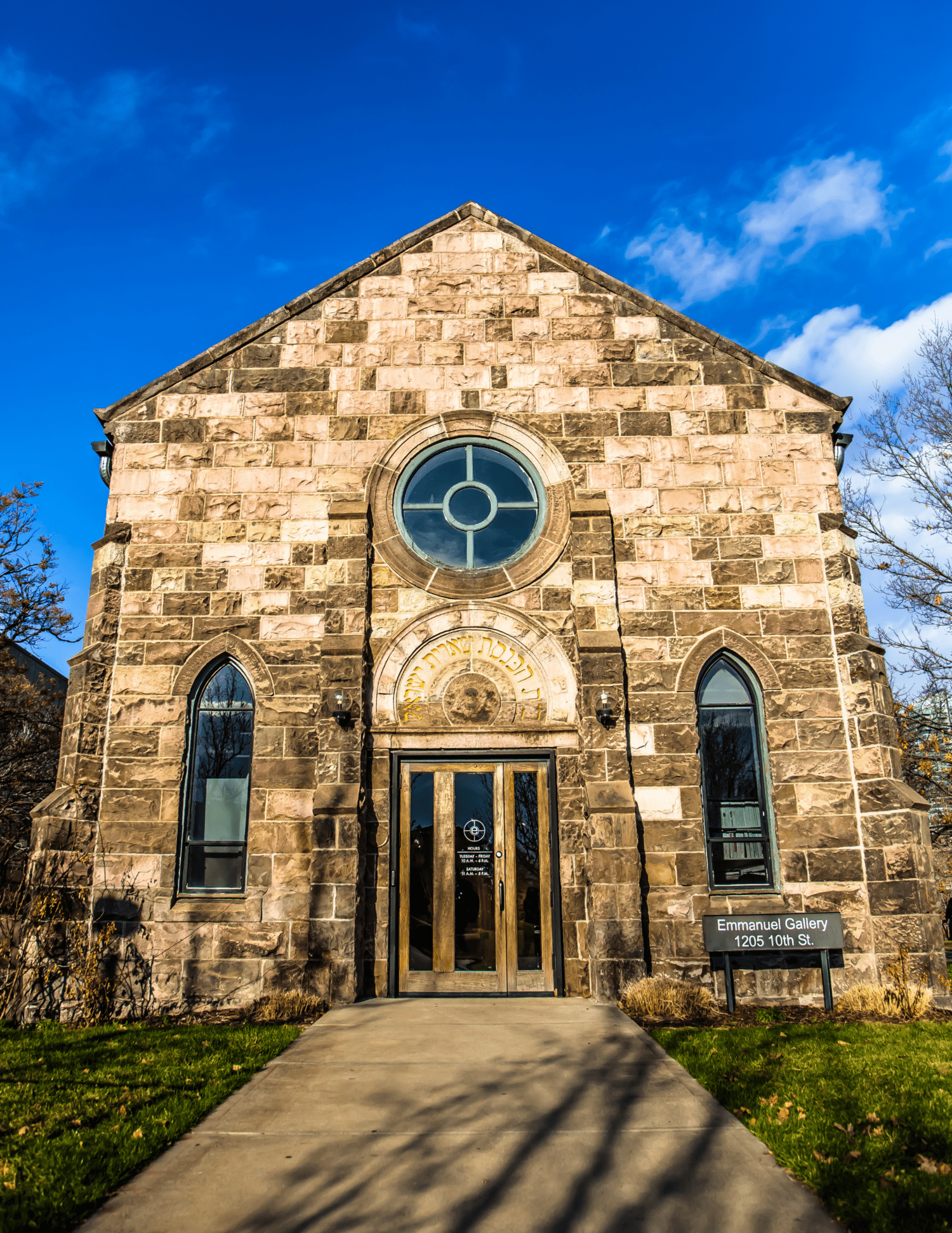Emmanuel Art Gallery
1205 10th Street

Fast Facts
Architect: L. Gale Abels Associates Pioneers
Architectural Style: Neo-Gothic
Year Built: 1876
Designation: Denver Landmark National Historic Landmark
Neighborhood: Auraria
Original Building: Emmanuel Shearith Israel Chapel
Handicap Accessible
Emmanuel Art Gallery
Built in 1876, the Emmanuel Art Gallery is Denver’s oldest standing religious structure. In 1969, the Emmanuel Chapel was approved for listing on the National Register of Historic Places and was also the first building listed as a historic site by Denver’s Landmark Preservation Commission. In 1973, Emmanuel became part of the Auraria Campus –which includes the University of Colorado Denver, Metropolitan State University of Denver, and Community College of Denver. It has since been remodeled for use as an art gallery and is managed by the University of Colorado Denver.
Episcopal Church
In 1873, Episcopalians in west Denver formed the Emmanuel Mission. The group started holding Sunday School at a grammar school building at the corner of 11th and Lawrence Streets. It soon grew to seventy members. The group constructed a small stone church at the north corner of 10th and Lawrence. The church was designed using a combination of Romanesque and Gothic styles and was consecrated on September 24, 1877 (Etter, 1972).
The Emmanuel Episcopal Church was the second Episcopal church in Denver. It remained at its 10th and Lawrence location until the early 1890s. By that time the character of west Denver was changing as wealthier residents moved south of Colfax Avenue. Unable to maintain a congregation at 10th and Lawrence, Emmanuel Episcopal moved in 1893 to a new building several blocks south. The Episcopal Church continued to own the building at 10th and Lawrence. In the 1890s, the Young Ladies Guild of St. John’s Cathedral operated a social welfare mission there. The building started to be known as St. Andrew’s Church and was used as the meeting place for a group of Anglo-Catholics that included White members from England and Black members from Memphis, Tennessee (du Pont Breck, 1963).
Jewish Synagogue
In the 1880s and 1890s, a diverse mix of ethnic groups, including eastern European Jews, began to move into west Denver. These new Jewish immigrants did not quite fit in with the city’s existing community of cosmopolitan German Jews, who had established the city’s oldest Jewish congregation, Temple Emanuel, in 1874. Instead, the new Jewish immigrants started many small congregations of their own, such as Shomro Amuno (Keepers of the Faith), which tended to reflect the local dialect and customs of their homelands in Eastern Europe.
In the 1890s, Shomro Amuno had a synagogue on the east bank of Cherry Creek known as the Cherry Creek Shul. In 1898, Shomro Amuno moved out and started to hold its services in rented halls and stores. In 1899, it joined another group that also held services in nearby stores, and the combined congregation took the name Shearith Israel (Remnant of Israel).
For four years Shearith Israel held services in rented halls, but in 1903 the group was able to buy the old Emmanuel Episcopal Church. Men from the congregation repaired the building and converted it into a synagogue. Shearith Israel survived as long as there was a Jewish community in west Denver (Abrams, 2007).
After World War I, the city’s Jewish community began to disperse from downtown and west Denver. Shearith Israel still had 60 members in 1920, but the area’s Jewish population was already in decline. By 1942 the congregation counted only 15 members. Eventually, all the other west Denver shuls closed, leaving Shearith Israel as the last congregation in the area. The synagogue closed for good in 1958 (du Pont Breck, 1960).
Art Gallery
After the synagogue closed, the artists Wolfgang and Susan Pogzeba rented the building for several years before eventually buying it in 1963. They updated the building’s wiring and plumbing but otherwise left it largely unchanged. As plans for a vast urban renewal project in west Denver took shape in the late 1960s, the old church and synagogue began to receive historic designations to protect it from potential destruction. In 1968, it became the city’s first designated landmark, and in 1969 it was listed on the National Register of Historic Places.
In 1973, the Auraria Higher Education Center bought the building. It was renovated in 1976 to become the campus art gallery. Now known as the Emmanuel Gallery, it regularly hosts exhibitions of work by students, professors and other artists. Although the building’s interior has changed over the years, it still has a Hebrew inscription over its door as a reminder of its past.
Photos Courtesy of Emmanuel Art Gallery
References
Fink, R. 1969. Emmanuel Shearith Israel Chapel National Register of Historic Places Nomination Form.
Etter, D. 1972. Auraria: Where Denver Began. Boulder: Colorado Associated University Press.
du Pont Breck, A. 1963. The Episcopal Church in Colorado, 1860–1963. Denver: Big Mountain Press.
Abrams, J. 2007. Jewish Denver, 1859–1940, Images of America. Charleston, SC: Arcadia.
du Pont Breck, A. 1960. The Centennial History of the Jews of Colorado, 1859–1959. Denver: Hirschfeld Press.